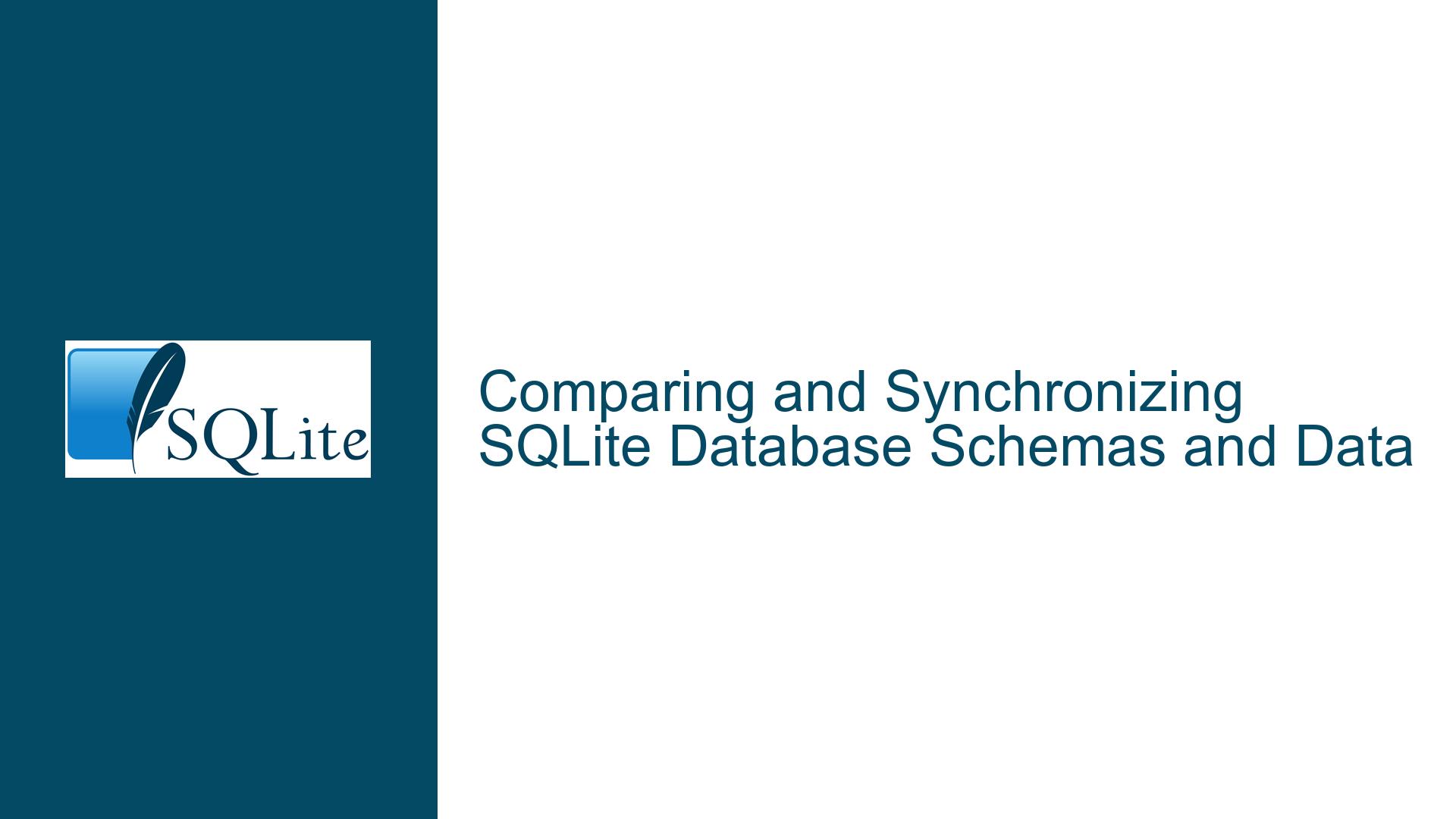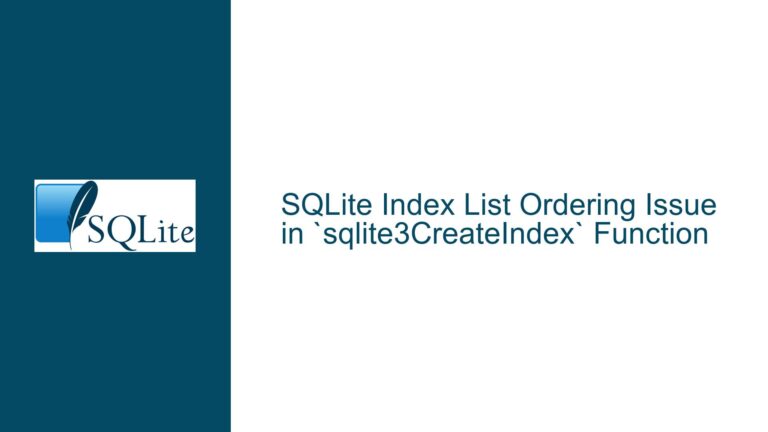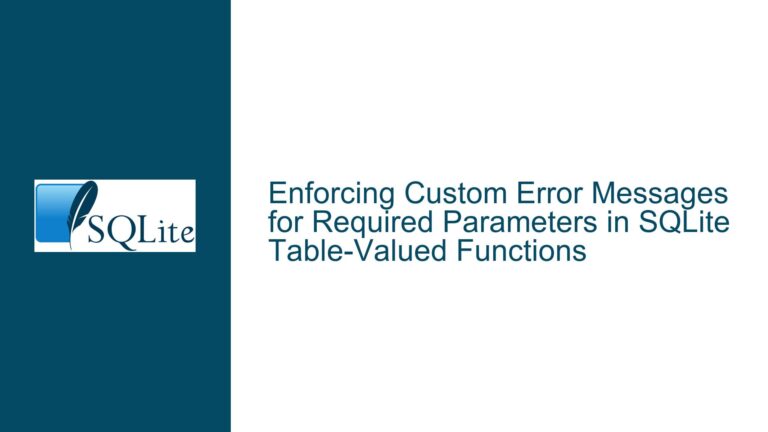Comparing and Synchronizing SQLite Database Schemas and Data
Understanding the Need for Database Comparison and Synchronization
When working with SQLite databases, especially in the context of software development, it is common to encounter scenarios where you need to compare two databases to identify differences in their schemas or data. This need often arises during software updates, where the database schema may evolve to accommodate new features or changes in the application logic. The ability to compare databases is crucial for ensuring that the database structure is consistent across different versions of the application and that data migrations are performed correctly.
The process of comparing databases involves examining the structure (tables, columns, indexes, etc.) and, in some cases, the data contained within those structures. The goal is to identify discrepancies between the two databases so that appropriate actions can be taken to synchronize them. This synchronization might involve altering the schema of one database to match the other, migrating data from one database to another, or both.
In the context of SQLite, comparing databases can be particularly challenging due to the lack of built-in tools that provide a comprehensive comparison of both schema and data. While SQLite does offer some utilities, such as sqldiff, these tools may not cover all the nuances of database comparison, especially when dealing with complex schemas or large datasets. Therefore, understanding the available tools, their limitations, and how to use them effectively is essential for anyone responsible for maintaining SQLite databases.
Exploring the Limitations of SQLite’s Built-in Tools
SQLite provides a utility called sqldiff that can be used to compare two databases and generate a list of differences. The sqldiff tool is designed to identify discrepancies in both the schema and the data between two SQLite databases. However, while sqldiff is a useful tool, it has certain limitations that can make it less effective in some scenarios.
One of the primary limitations of sqldiff is that it does not provide a detailed breakdown of schema differences. For example, if a table in one database has a different set of columns compared to the same table in another database, sqldiff may not provide a clear explanation of what exactly has changed. Instead, it might simply indicate that the table structure is different, leaving it up to the user to manually inspect the schema to determine the specific changes.
Another limitation of sqldiff is that it does not handle certain types of schema changes well. For instance, if a column is renamed or if a table is split into multiple tables, sqldiff may not recognize these changes as schema differences. Instead, it might treat the renamed column as a deleted column in one database and a new column in the other, leading to confusion when trying to synchronize the databases.
Additionally, sqldiff is primarily focused on comparing the data within tables rather than the schema itself. While it can identify differences in the data, it may not be as effective in identifying structural changes that do not affect the data directly. This can be problematic when the goal is to ensure that the schema of two databases is consistent, regardless of whether the data within those schemas is the same.
Given these limitations, it is important to consider alternative approaches to comparing SQLite databases, especially when dealing with complex schemas or when a more detailed analysis of schema differences is required. This might involve using third-party tools, writing custom scripts, or employing a combination of both to achieve the desired level of comparison and synchronization.
Step-by-Step Guide to Comparing and Synchronizing SQLite Databases
To effectively compare and synchronize SQLite databases, it is important to follow a systematic approach that takes into account both the schema and the data. The following steps outline a comprehensive method for identifying differences between two SQLite databases and taking appropriate actions to synchronize them.
Step 1: Use sqldiff for Initial Comparison
The first step in comparing two SQLite databases is to use the sqldiff tool to generate a list of differences. This tool can be invoked from the command line and requires the paths to the two database files as arguments. The output of sqldiff will provide a high-level overview of the differences between the databases, including discrepancies in both the schema and the data.
While sqldiff is a good starting point, it is important to keep in mind its limitations, as discussed earlier. The output from sqldiff should be carefully reviewed to identify any areas where the tool may have missed or misrepresented differences. In particular, pay attention to any schema changes that may not have been accurately captured by sqldiff.
Step 2: Manually Inspect Schema Differences
After running sqldiff, the next step is to manually inspect the schema of both databases to identify any differences that may not have been detected by the tool. This can be done by querying the sqlite_master table in each database, which contains the schema information for all tables, indexes, and other objects.
By comparing the output of queries against the sqlite_master table in both databases, you can identify discrepancies in table definitions, column types, indexes, and other schema elements. This manual inspection is particularly important for detecting changes such as column renames, table splits, or other structural modifications that sqldiff may not handle well.
Step 3: Compare Data Differences
Once the schema differences have been identified and addressed, the next step is to compare the data within the tables of both databases. This can be done by writing custom SQL queries that compare the contents of corresponding tables in the two databases. For example, you can use EXCEPT or UNION queries to identify rows that are present in one database but not the other.
In cases where the data differences are significant, it may be necessary to write more complex queries or scripts to handle the synchronization of data. This might involve merging data from both databases, resolving conflicts where the same row has different values in each database, or migrating data from one database to another.
Step 4: Apply Schema Changes
After identifying the schema differences, the next step is to apply the necessary changes to one of the databases to bring it in line with the other. This might involve creating new tables, adding or modifying columns, or updating indexes. These changes can be applied using standard SQL ALTER TABLE statements or by executing a series of CREATE, DROP, and ALTER statements as needed.
It is important to carefully plan and test these schema changes to ensure that they do not introduce any issues or data loss. In some cases, it may be necessary to create a backup of the database before applying the changes, especially if the changes are complex or involve significant modifications to the schema.
Step 5: Synchronize Data
Once the schema changes have been applied, the final step is to synchronize the data between the two databases. This can be done by writing custom SQL scripts or using a tool designed for data migration. The goal is to ensure that the data in both databases is consistent and that any discrepancies have been resolved.
In some cases, it may be necessary to perform a full data migration, where all data from one database is transferred to the other. This might be required if the schema changes are extensive or if the data in one database is significantly out of sync with the other. In other cases, a more targeted approach may be sufficient, where only specific tables or rows are synchronized.
Step 6: Verify the Synchronization
After applying the schema changes and synchronizing the data, it is important to verify that the two databases are now consistent. This can be done by running sqldiff again to confirm that no differences remain. Additionally, you should manually inspect the schema and data to ensure that all changes have been applied correctly and that no issues have been introduced.
In conclusion, comparing and synchronizing SQLite databases requires a combination of tools, manual inspection, and careful planning. By following the steps outlined above, you can effectively identify and resolve differences between two databases, ensuring that they are consistent and up-to-date. While sqldiff is a useful tool, it is important to be aware of its limitations and to supplement it with manual checks and custom scripts as needed. With the right approach, you can maintain the integrity of your SQLite databases and ensure that they evolve smoothly alongside your application.






